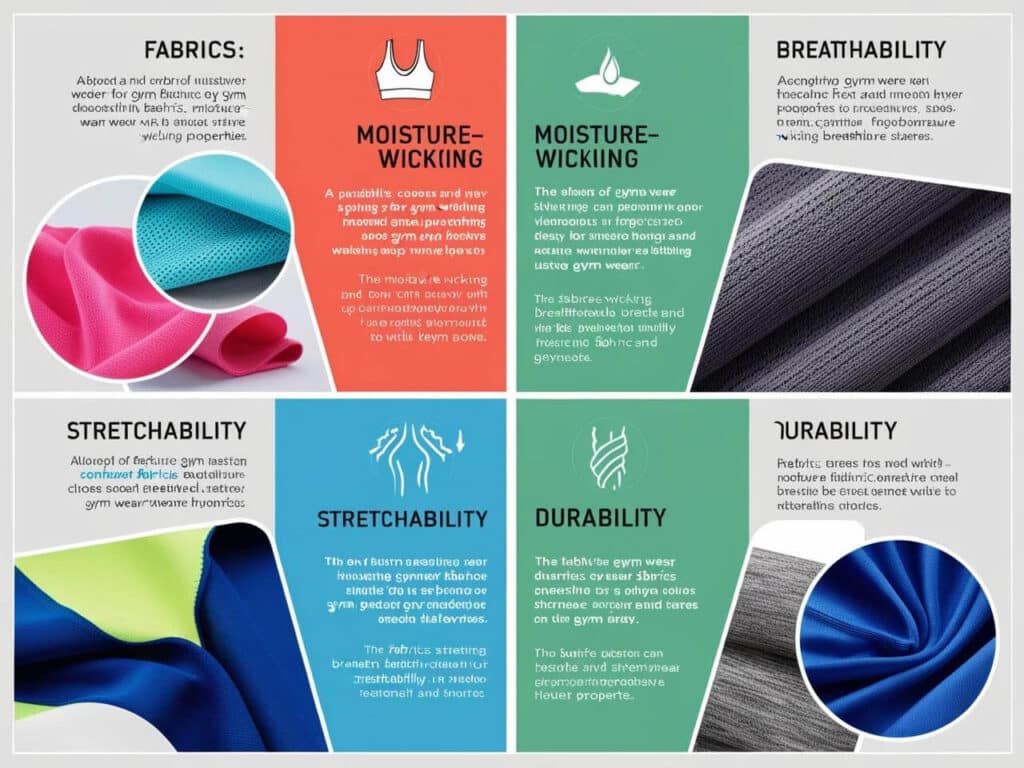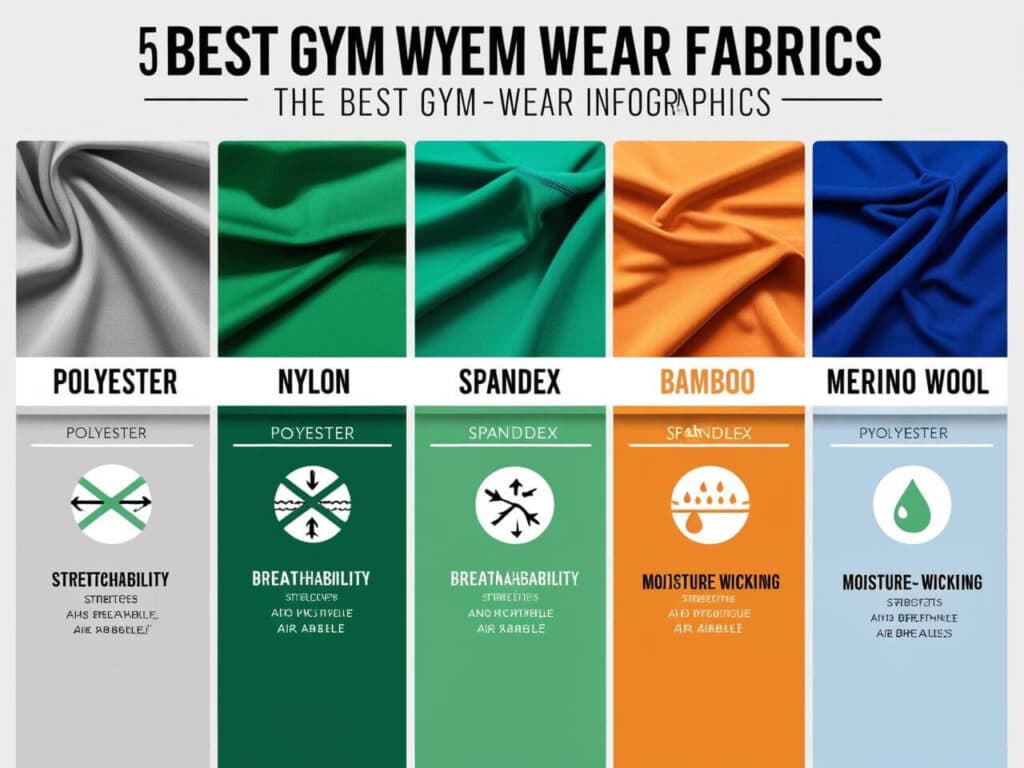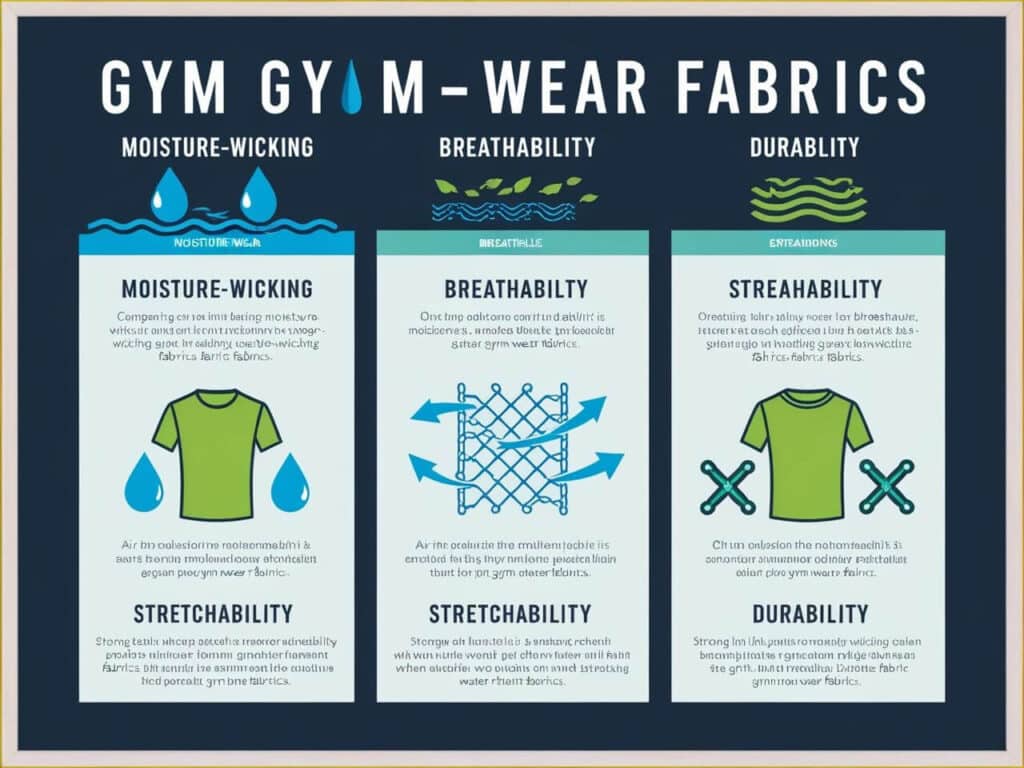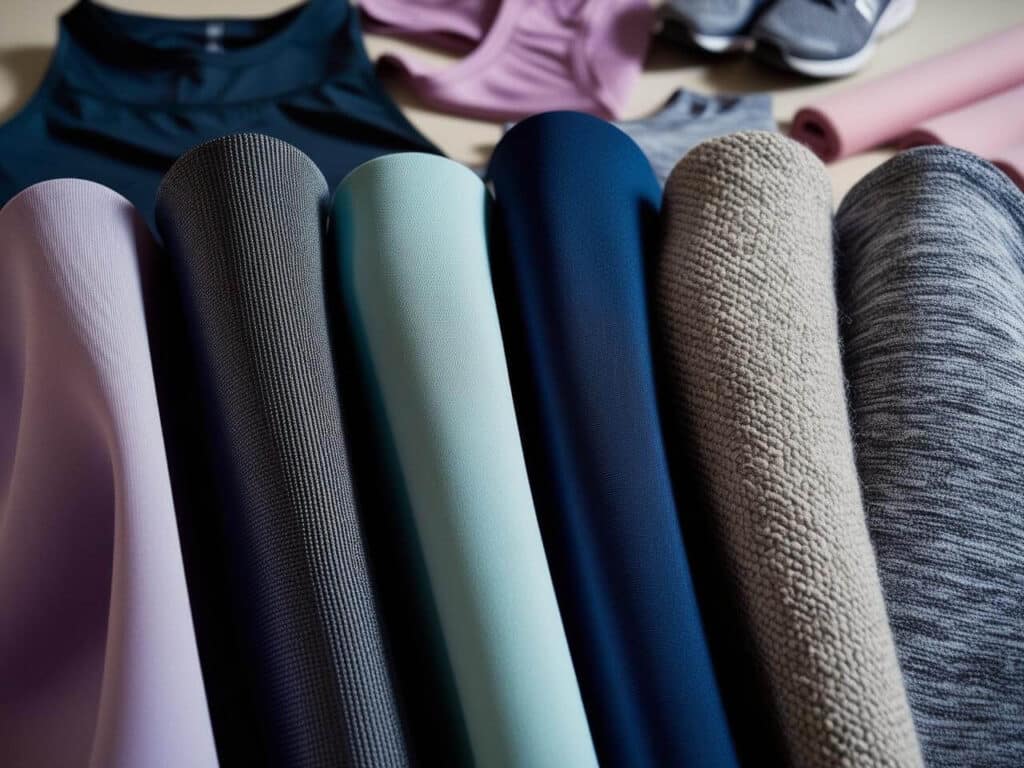Introduction
When it comes to gym wear, fabric matters more than you think. The right material can help you stay cool, dry, and comfortable, while the wrong choice might leave you soaked in sweat and restricted in movement.
Over the years, I’ve tested dozens of gym wear fabrics—some worked perfectly, while others felt like a sweaty nightmare. If you’ve ever wondered which fabric is best for workouts, you’re in the right place.
In this guide, I’ll break down:
- The best fabrics for gym wear and why they work
- How different materials impact performance
- A comparison of polyester, nylon, spandex, bamboo, and merino wool
The Key Factors in Choosing Gym Wear Fabrics

Not all fabrics are created equal when it comes to workout performance. The best gym wear materials need to balance comfort, breathability, durability, and flexibility.
Here are the four key factors to consider when choosing the right fabric:
1️⃣ Moisture-Wicking 💦
✔ Why it matters: Sweat management is essential to stay dry and prevent discomfort during intense workouts.
✔ Best fabrics: Polyester, nylon, and bamboo absorb sweat and dry quickly.
✔ Worst fabrics: Cotton absorbs sweat but takes too long to dry, making it a poor choice for gym wear.
2️⃣ Breathability 🌬
✔ Why it matters: Breathable fabrics allow air to flow, keeping you cool and comfortable.
✔ Best fabrics: Merino wool, bamboo, and nylon provide excellent airflow while preventing odor buildup.
✔ Worst fabrics: Thick synthetic blends can trap heat and cause excessive sweating.
3️⃣ Stretchability & Flexibility 🤸♂️
✔ Why it matters: Gym wear must move with your body, especially for yoga, weightlifting, and HIIT workouts.
✔ Best fabrics: Spandex (Lycra) blends with polyester or nylon offer maximum stretch and recovery.
✔ Worst fabrics: Rigid or non-stretch materials limit mobility and comfort.
4️⃣ Durability 🔥
✔ Why it matters: Gym wear needs to withstand sweat, frequent washing, and high-impact movement.
✔ Best fabrics: Polyester and nylon last the longest and maintain shape after multiple washes.
✔ Worst fabrics: Pure cotton loses structure over time and shrinks easily.
Top 5 Fabrics Used in Gym Wear

Different workouts require different types of fabrics. Whether you’re doing high-intensity training, yoga, or outdoor running, the right material can improve comfort, performance, and durability.
Here are the top 5 fabrics commonly used in gym wear and their benefits:
1️⃣ Polyester – The Most Popular Gym Fabric
✔ Lightweight & Durable – Withstands frequent washing without losing shape.
✔ Quick-Drying – Moisture-wicking to keep sweat away from the skin.
✔ Affordable – A cost-effective option used in most activewear.
🔻 Potential Downsides: Can retain odor over time if not washed properly.
📌 Best for: General gym wear, running, and outdoor workouts.
2️⃣ Nylon – Soft, Flexible, and Sweat-Wicking
✔ Stretchable & Comfortable – Feels smooth and flexible on the skin.
✔ Sweat-Resistant – Quickly absorbs and dries moisture.
✔ Durable – Resistant to mildew and shrinkage.
🔻 Potential Downsides: Slightly more expensive than polyester.
📌 Best for: Leggings, sports bras, and compression wear.
3️⃣ Spandex (Lycra/Elastane) – Maximum Flexibility
✔ 4-Way Stretch – Ideal for high-movement activities.
✔ Compression Benefits – Enhances muscle support and recovery.
✔ Blends Well – Often mixed with polyester or nylon for extra flexibility.
🔻 Potential Downsides: Can lose elasticity if not washed properly.
📌 Best for: Yoga, HIIT workouts, and form-fitting activewear.
4️⃣ Bamboo Fabric – Natural, Breathable, and Antibacterial
✔ Eco-Friendly – Sustainable and biodegradable.
✔ Super Soft – Feels softer than cotton and gentle on sensitive skin.
✔ Odor-Resistant – Natural antibacterial properties keep gym wear fresh.
🔻 Potential Downsides: More expensive and less durable than synthetic fabrics.
📌 Best for: Eco-friendly gym wear and casual activewear.
5️⃣ Merino Wool – Temperature Regulating & Odor Resistant
✔ All-Weather Comfort – Keeps you warm in winter and cool in summer.
✔ Moisture-Wicking – Absorbs sweat while remaining dry to the touch.
✔ Odor Control – Naturally resists bacteria and sweat odor.
🔻 Potential Downsides: Higher price point compared to synthetic fabrics.
📌 Best for: Outdoor workouts, hiking, and cold-weather training.
🔗 External Resource:
How to Choose the Right Fabric for Your Workout

Not all gym wear fabrics are suitable for every workout. Choosing the right material depends on activity type, intensity, and environment.
Here’s how to pick the best fabric for your specific workout needs:
🏋️♂️ Strength Training & Weightlifting
✔ Best Fabrics: Nylon & Spandex
✔ Why?
- Provides maximum flexibility for unrestricted movement.
- Moisture-wicking to keep you dry.
- Compression properties help with muscle support & recovery.
📌 Recommended for: Leggings, compression tops, fitted gym wear.
🏃♂️ Cardio & High-Intensity Workouts
✔ Best Fabrics: Polyester & Spandex
✔ Why?
- Fast-drying & lightweight, perfect for intense sweating.
- Keeps body cool & ventilated during high movement.
- Retains shape & durability even after frequent washing.
📌 Recommended for: Running shorts, sweat-wicking tops, HIIT workout wear.
🧘 Yoga & Pilates
✔ Best Fabrics: Bamboo & Spandex
✔ Why?
- Super soft & breathable, perfect for long sessions.
- Natural antibacterial properties reduce odor.
- 4-way stretch for better movement flexibility.
📌 Recommended for: Yoga leggings, fitted tops, and breathable activewear.
🌲 Outdoor & Cold-Weather Training
✔ Best Fabrics: Merino Wool & Polyester Blends
✔ Why?
- Temperature-regulating to keep you warm or cool as needed.
- Odor-resistant for extended wear.
- Moisture-wicking to prevent excessive sweat buildup.
📌 Recommended for: Base layers, thermal leggings, and outdoor running gear.
🎥 YouTube Video Suggestion:
How to Choose the Best Activewear Fabric
Gym Wear Fabric Comparison Table

To make it easier to compare different fabrics, here’s a detailed side-by-side comparison of the most common gym wear materials.
| Fabric | Moisture-Wicking | Breathability | Stretchability | Durability | Best For |
| Polyester | ✅ High | ⚠️ Medium | ✅ High | ✅ High | Running, general workouts |
| Nylon | ✅ High | ✅ High | ✅ High | ✅ High | Strength training, compression wear |
| Spandex | ⚠️ Low | ✅ High | ✅✅ Maximum | ✅ High | Yoga, HIIT workouts, flexibility training |
| Bamboo | ✅ High | ✅✅ Excellent | ✅ High | ⚠️ Medium | Eco-friendly gym wear, casual workouts |
| Merino Wool | ✅✅ Excellent | ✅ High | ⚠️ Medium | ✅ High | Cold-weather training, outdoor sports |
🔗 External Resource:
FAQs (People Also Ask)
Here are some of the most common questions people ask about gym wear fabrics and their performance.
❓ Which fabric is best for gym wear?
✔ Polyester and nylon are the most commonly used fabrics for gym wear due to their moisture-wicking, durability, and breathability.
❓ Is cotton good for gym wear?
✔ No, cotton absorbs sweat but does not dry quickly, making it uncomfortable for high-intensity workouts.
❓ What’s the difference between polyester and nylon for gym wear?
✔ Polyester is more affordable and moisture-wicking, while nylon is softer, stretchier, and more durable.
❓ Does gym wear fabric affect performance?
✔ Yes! Breathable, moisture-wicking, and stretchable fabrics help regulate body temperature, improve movement, and keep you comfortable during workouts.
❓ What fabric is best for sweaty workouts?
✔ Polyester, nylon, and bamboo are the best choices because they wick away moisture and dry quickly, keeping you sweat-free.
Choosing the Best Fabric for Your Gym Wear
Choosing the right gym wear fabric directly impacts your workout performance and comfort. Whether you’re lifting weights, running, or practicing yoga, the right material will help you stay dry, flexible, and comfortable.
✔ Summary of the Best Fabrics:
- Polyester & Nylon – Best for general workouts and sweat management.
- Spandex – Perfect for flexibility and stretchability.
- Bamboo – A sustainable, odor-resistant alternative.
- Merino Wool – Ideal for cold-weather and outdoor training.
✔ Final Tips:
- Always choose moisture-wicking fabrics to keep sweat away.
- If flexibility is key, opt for spandex blends.
- For sustainable choices, consider bamboo or Merino wool.
Final Thoughts
No matter your workout style, wearing the right fabric can improve your performance and comfort. Investing in high-quality gym wear will keep you feeling great and ready to crush your fitness goals.
